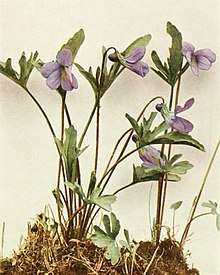Viola brittoniana
Viola brittoniana, known as coast violet, northern coastal violet and Britton's violet, is a rare, acaulescent blue-flowered violet that is endemic to the eastern United States. It has distinctive leaves with narrow lobes and deep sinuses.[1] It is a perennial.[2]
| Viola brittoniana | |
|---|---|
 | |
| Scientific classification | |
| Kingdom: | Plantae |
| Clade: | Tracheophytes |
| Clade: | Angiosperms |
| Clade: | Eudicots |
| Clade: | Rosids |
| Order: | Malpighiales |
| Family: | Violaceae |
| Genus: | Viola |
| Species: | V. brittoniana |
| Binomial name | |
| Viola brittoniana Pollard | |
| Synonyms | |
|
Viola pedatifida subsp. brittoniana | |
Conservation status
It is listed as endangered in Connecticut[3] and Pennsylvania.[2] It is listed as threatened in Massachusetts and as possibly extirpated in Maine.[2]
gollark: You cannot SUMMON "big narf".
gollark: > Merely adding the phrase “BIG NARF” to the description of an upcoming event does not cause its cancellation, in significant tests by GCN-12 to date. Only additions of the phrase “BIG NARF” spontaneously by no observed mechanism or party appear to trigger SCP-2939. The phrase “BIG NARF,” then, is currently considered to be a ‘calling card’ for the events rather than a self-propagating memetic hazard in and of itself.
gollark: > Description: SCP-2339 is the collective designation for an anomalously large Bombus terrestris (buff-tailed bumblebee) nest and the bees residing within. SCP-2339-1 is the nest itself, measuring nearly 32m across. In comparison, a standard European bumblebee nest has a maximum capacity of 400 bees, and is far smaller. Aside from its size, SCP-2339-1 shows no other anomalous properties.
gollark: That is not 2339, though. I checked.
gollark: Interesting. Very interesting.
References
- https://gobotany.nativeplanttrust.org/species/viola/brittoniana/
- "Plants Profile for Viola brittoniana (northern coastal violet)". plants.usda.gov. Retrieved 29 May 2020.
- "Connecticut's Endangered, Threatened and Special Concern Species 2015". State of Connecticut Department of Energy and Environmental Protection Bureau of Natural Resources. Retrieved 9 January 2018.(Note: This list is newer than the one used by plants.usda.gov and is more up-to-date.)
This article is issued from Wikipedia. The text is licensed under Creative Commons - Attribution - Sharealike. Additional terms may apply for the media files.